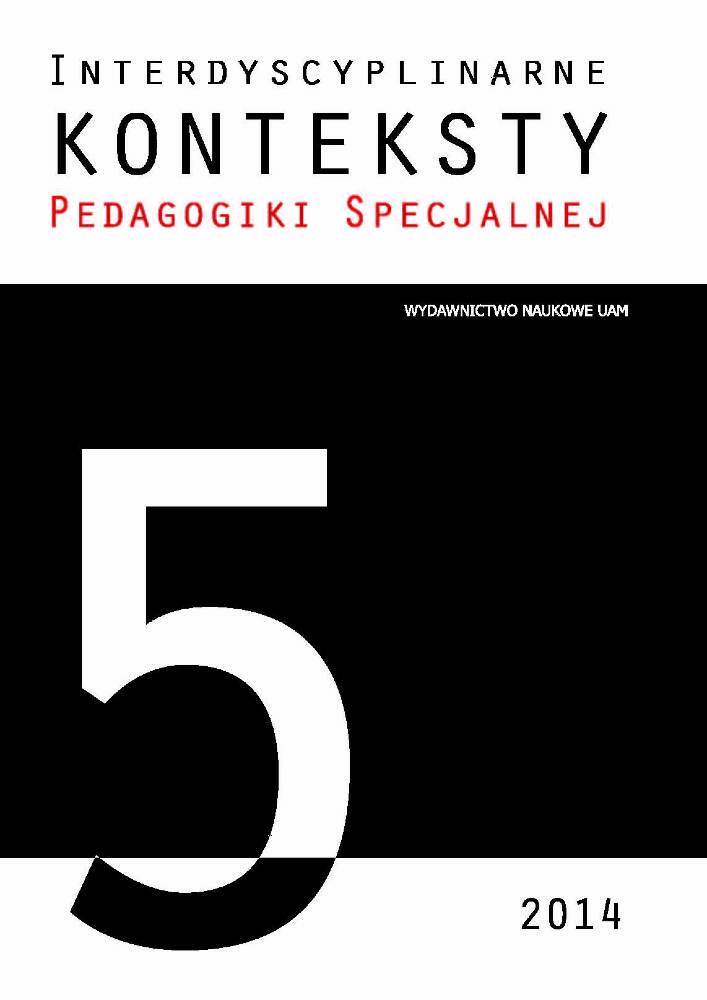Abstrakt
Everyday new technology is changing the lives in ways we never imagined. For individual with autism spectrum disorder (ASD), some new technologies can improve communication, assist in the development of social skills and enhance the ability to learn. This paper discusses the concepts of Universal Design for Learning as a context for exploring the use if assistive technology in supporting the developmental of social skill training for children with ASD.
Bibliografia
AAC-RERC The Rehabilitation Engineering Research Center on Communication Enhancement, AAC-RERC white paper on Mobile devices and communication Apps [White Paper], 2011, retrieved from http://aac-rerc.psu.edu/index.php/ pages/show/id/46.
CAMPBELL P.H., MILBOURNE S., DUGAN L.M., WILCOX M.J., A review of evidence on practices for teaching young children to use assistive technology devices, “Topics in Early Childhood Special Education”, 2006, 26, p. 3–13.
CAST, Universal Design for Learning guidelines version 1.0, Wakefield MA 2008.
Center for Applied Special Technology (CAST), Planning for all learners (PAL)
Toolkit, Wakefield MA 2004.
DEC/NAEYC, Early childhood inclusion: A joint position statement of the Division for Early Childhood (DEC) and the National Association for the Education of Young Children (NAEYC), The University of North Carolina, FPG Child Development Institute, Chapel Hill 2009.
ELLIS S., Teaching the future, “Screen Education”, 2011, 63, p. 60–64.
FETIG A., Social Skills training (SST) fact sheet, The University of North Carolina, Frank Porter Graham Child Development Institute, The National Professional Development Center on Autism Spectrum Disorders, Chapel Hill 2013.
FLORES M., MUSGROVE K., RENNER S., HINTON V., STROZIER S., FRANKLIN S. et al., A comparison of communication using the Apple iPad and a picture-based communi-cation system, “Augmentative and Alternative Communication”, 2012, 28, p. 74–84.
GORDON D.T., GRAVEL J.W., SCHIFTER L.A., A policy reader in universal design for learning, Harvard Education Press, Cambridge MA 2009, p. 209–218.
GRAY C., Social stories 10.0: the new defining criteria and guidelines, “Jenison Autism Journal”, 2004, 15(1), p. 1–26.
HOURCADE J.P., WILLIAMS S.R., MILLER E.A., HUEBNER K.E., LIANG L.J., Evaluation of tablet apps to encourage social interaction in children with autism spectrum disorders, Honorable Mention, ACM, New York NY 2013, p. 3197–3206.
KAGOHARA D.M., VAN DER MEER L., RAMDOSS S., O’REILLY M.F., LANCIONI G.E., DAVIS T.N., RISPOLI M., LANG R., MARSCHIK P.B., SUTHERLAND D., GREEN V.A., SIGAFOOS J., Using iPods and iPad® in teaching programs for individuals with deve-lopmental disabilities: A systemic review, “Research in Developmental Disabilities”, 2013, 34, p. 147–156.
MEO G., Curriculum planning for all learners; applying universal design for learning (UDL) to a high school reading comprehension program, “Preventing School Failure”, 2008, 52(2), p. 21–30.
MEYER A., ROSE D.H., The future is in the margins: The role of technology and disability in educational reform, [in:] The universally designed classroom: Accessible curriculum and digital technologies, ed. D.H. Rose, A. Meyer, C. Hitchcock, Harvard Education Press, Cambridge MA 2005, p. 13–35.
MISTRETT S., Assistive Technology helps young children with disabilities participate in daily activities, “Technology In Action”, 2004, 1(4), p. 1–7.
MORE C., Social stories and young children: Strategies for teachers, “Intervention in School and Clinic”, 2012, 47(3), p. 167–174.
MORE C., SILEO N., HIGGINGS K., TANDY R., TANNOCK M., The effects of social story interventions with preschool age children with and without disabilities, “Early Child Development and Care”, 2013, 183(1), p. 1–16.
O’MALLEY P., LEWIS M.E.B., DONEHOWER C., Using Tablet Computers as Instructional Tools to Increase Task Completion by Students with Autism. Paper presented at the Annual Meeting of the American Educational Research Association (San Francisco CA, Apr 27 – May 1, 2013), 2013, retrieved from http://eric.ed.gov/?id=ED541157.
PRICE A., Making a difference with smart tablets, “Teacher Librarian”, 2011, 39(1),p. 31–34.
ROSE D.H., GRAVEL J.W., Universal design for learning, [in:] International Encyclopedia of Education, 3rd Ed., ed. E. Baker, P. Peterson, B. McGaw, Elsevier, Oxford 2010.
ROSE D.H., MEYER A., Teaching every student in the digital age: Universal Design for Learning, Association for Supervision and Curriculum Development, Alexandria VA 2002.
SANDVIK M., SMØRDAL O., ØSTERUD S., Exploring iPad® in practitioners'repertoires for language learning and literacy practices in kindergarten, “Nordic Journal of Digital Literacy”, 2012, 7(3), p. 204–220.
SHAH N., Special Ed. Pupils Find Learning Tool In iPad Applications, “Education Week”, 2011, 30(22), p. 1–17.
Technology Related Assistance for Individuals with Disabilities Act of 1988, 29 U.S.C. § 2202 (West 1988), http://www.iidc.indiana.edu/?pageId=2504#sthash. HPKtipnA.dpuf.
TEST D., RICHTER S., KNIGHT V., SPOONER F., A comprehensive review and meta-analysis of the social stories literature, “Focus on Autism & Other Developmental Disabilities”, 2011, 26(1), p. 49–62.
VANDERBORGHT B., SIMUT R., SALDIEN J., POP C., RUSU A., PINTEA S., LEFEBER D., DAVID D., Using the social robot probot as a social story telling agent for children with asd, “Interaction Studies”, 2012, 13(3), p. 348–372.
WONG C., Social narratives (SN) fact sheet, The University of North Carolina, Frank Porter Graham Child Development Institute, The National Professional Deve-lopment Center on Autism Spectrum Disorders, Chapel Hill 2013.
